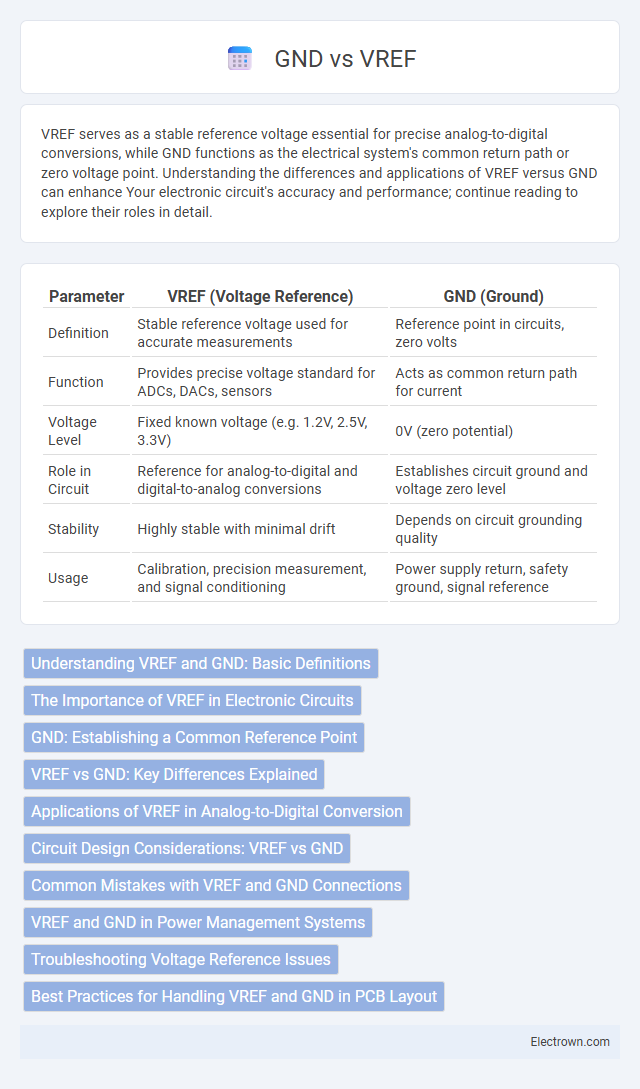VREF serves as a stable reference voltage essential for precise analog-to-digital conversions, while GND functions as the electrical system's common return path or zero voltage point. Understanding the differences and applications of VREF versus GND can enhance Your electronic circuit's accuracy and performance; continue reading to explore their roles in detail.
Table of Comparison
| Parameter | VREF (Voltage Reference) | GND (Ground) |
|---|---|---|
| Definition | Stable reference voltage used for accurate measurements | Reference point in circuits, zero volts |
| Function | Provides precise voltage standard for ADCs, DACs, sensors | Acts as common return path for current |
| Voltage Level | Fixed known voltage (e.g. 1.2V, 2.5V, 3.3V) | 0V (zero potential) |
| Role in Circuit | Reference for analog-to-digital and digital-to-analog conversions | Establishes circuit ground and voltage zero level |
| Stability | Highly stable with minimal drift | Depends on circuit grounding quality |
| Usage | Calibration, precision measurement, and signal conditioning | Power supply return, safety ground, signal reference |
Understanding VREF and GND: Basic Definitions
VREF (Voltage Reference) is a stable voltage source used as a benchmark for analog-to-digital converters (ADCs) and other precision measurement devices to ensure accurate and consistent readings. GND (Ground) serves as the zero-voltage reference point in electrical circuits, providing a common return path for current and establishing a baseline for all voltage measurements. Understanding the difference between VREF and GND is crucial for circuit design, as VREF sets the measurement scale while GND maintains the circuit's stability and safety.
The Importance of VREF in Electronic Circuits
VREF serves as a stable voltage reference essential for the accurate operation of analog-to-digital converters (ADCs) and digital-to-analog converters (DACs) in electronic circuits, ensuring precise signal measurement and processing. Unlike GND, which represents the zero voltage potential, VREF provides a fixed, known voltage against which signals are compared, directly impacting the accuracy and reliability of sensor readings and control systems. Your circuit's performance and measurement fidelity depend on the proper selection and stability of VREF, making it a critical component in precision electronics design.
GND: Establishing a Common Reference Point
GND, or ground, establishes a common reference point in electrical circuits, ensuring stable voltage levels and accurate signal measurement. Unlike VREF, which provides a specific reference voltage for comparison or regulation, GND serves as the zero-voltage baseline for all circuit components. Understanding the role of GND helps you design reliable and consistent electronics by maintaining a universal reference framework.
VREF vs GND: Key Differences Explained
VREF (Voltage Reference) provides a stable and precise voltage level used for accurate analog-to-digital conversion or sensor calibration, whereas GND (Ground) serves as the common return path for electrical current and a reference point for circuit voltages. VREF maintains a consistent voltage independent of load variations, essential for reliable measurements, while GND represents zero volts and acts as the baseline for voltage comparisons in electronic circuits. Understanding the distinction is crucial for designing circuits where precise voltage levels and stable references impact performance and accuracy.
Applications of VREF in Analog-to-Digital Conversion
VREF, or reference voltage, provides a stable and precise voltage against which an analog-to-digital converter (ADC) measures input signals, ensuring accurate digital output representation. It defines the maximum input voltage range for the ADC, directly influencing resolution and linearity in applications such as sensor interfacing, data acquisition systems, and precision instrumentation. Using VREF instead of GND as a reference enhances measurement stability by minimizing noise and voltage fluctuations common in ground lines.
Circuit Design Considerations: VREF vs GND
In circuit design, choosing between VREF and GND as a reference point impacts measurement accuracy and noise immunity. VREF provides a stable, precise voltage baseline, essential for high-resolution ADCs and DACs, while GND serves as the universal zero-volt reference but may introduce ground loop noise in sensitive applications. Your design must evaluate noise susceptibility, required precision, and system architecture to determine whether VREF or GND optimizes signal integrity and overall performance.
Common Mistakes with VREF and GND Connections
Common mistakes with VREF and GND connections include improper grounding, which causes inaccurate reference voltages and unstable circuit performance. Users often confuse VREF as a power ground instead of a precision reference, leading to noise interference and voltage fluctuations. Ensuring a dedicated, low-noise ground path for VREF and maintaining proper separation from GND helps achieve optimal voltage reference stability and measurement accuracy.
VREF and GND in Power Management Systems
VREF and GND are critical reference points in power management systems, with VREF providing a stable voltage reference essential for accurate analog-to-digital conversions and regulator stability. GND serves as the system's electrical ground, ensuring a common return path for current and minimizing noise interference. Your power management design relies on the precise differentiation between VREF and GND to maintain optimal performance and reliability.
Troubleshooting Voltage Reference Issues
When troubleshooting voltage reference (VREF) issues versus ground (GND), start by measuring the voltage levels between VREF and GND using a precise multimeter to ensure the reference voltage matches the expected value. Check for loose connections, damaged components, or noise interference affecting voltage stability, as variations can lead to inaccurate analog-to-digital conversions. Verifying the integrity of decoupling capacitors and confirming proper ground paths helps identify potential causes of voltage fluctuations in the VREF circuit.
Best Practices for Handling VREF and GND in PCB Layout
Careful separation of VREF and GND planes in your PCB layout reduces noise coupling and ensures signal integrity, especially for sensitive analog circuits. Using dedicated ground returns and avoiding shared current paths between VREF and GND prevents ground loops and voltage offsets. Optimal placement of decoupling capacitors near VREF pins stabilizes the reference voltage and enhances overall circuit performance.
VREF vs GND Infographic

 electrown.com
electrown.com